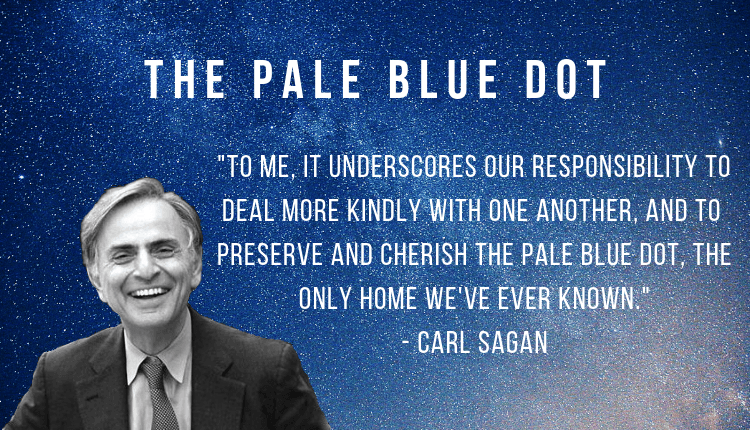The Pale Blue Dot

Carl Sagan was a renowned American astronomer who made significant contributions to his field. He was born on 9th of November, 1934 and earned his Ph.D. in Astronomy and Astrophysics in the year 1960. His doctoral research involved the computation of the first greenhouse model for Venus’ atmosphere, which showed a higher temperature than was previously suspected.
A Little about Carl Sagan
During his lifetime, he was deeply involved in the American Space Program right from its inception. He worked as an advisor for NASA and was involved in the designing and management of the Mariner 2 mission to Venus, Mariner 9, and Viking trips to Mars. In addition, Carl also played a crucial role in the Voyager missions to the outer solar system as well as the Galileo mission to Jupiter.
His efforts helped lay the groundwork for two new scientific disciplines, i.e., planetary science and exobiology, which involves the study of potential life on other planets. Some of his works not only involved significant research on planetary atmospheres but also covered astrobiology and the origin of life on Earth. However, he was known primarily as a spokesman for science and a popularizer of astronomy rather than his work. He spent a significant amount of time in improving the public understanding of science and also defending the rational nature of science.
Carl Sagan also helped educate people through his books and TV episodes. He worked as a writer and presenter on the television series “Cosmos: A Personal Voyage,” which was first aired on the Public Broadcasting Service in October 1980. This show was aired around the world and won an Emmy and a Peabody award. He also published a book on the same name, and it stayed in the New York Times best-seller list for 70 weeks.
Recognition of His Work
Carl was awarded the NASA Medals for Exceptional Scientific Achievement and Distinguished Public Service twice, as well as the NASA Apollo Achievement Award for his work. He was also awarded the John F. Kennedy Astronautics Award of the American Astronautical Society, the Explorers Club 75th Anniversary Award, the Konstantin Tsiolokovsky Medal of the Soviet Cosmonautics Federation, and the Masursky Award of the American Astronomical Society.
He was also awarded the Public Welfare Medal, the highest award of the National Academy of Sciences for “distinguished contributions in the application of science to public welfare” in 1994. Moreover, he also has an asteroid- Asteroid 2709 Sagan, named after him.
The Pale Blue Dot
As part of NASA’s Voyager mission, Voyager 1 was launched on September 5, 1977. On February 14, 1990, when Voyager 1 was 3.7 billion miles away from Earth, Carl Sagan, who was a member of the Voyager imaging team came up with a brilliant idea. He requested that the spacecraft be pointed back toward Earth and capture an image, which later became famously known as the “Pale Blue Dot.”
He then went on to share his reflections about what the picture meant and why it was important for us to capture it during a speech at Cornell University on October 13, 1994.
“We succeeded in taking that picture, and, if you look at it, you see a dot. That’s here. That’s home. That’s us. On it, everyone you ever heard of, every human being who ever lived, lived out their lives.
The aggregate of all our joys and sufferings, thousands of confident religions, ideologies and economic doctrines, every hunter and forager, every hero and coward, every creator and destroyer of civilizations, every king and peasant, every young couple in love, every hopeful child, every mother and father, every inventor and explorer, every teacher of morals, every corrupt politician, every superstar, every supreme leader, every saint and sinner in the history of our species, lived there — on a mote of dust, suspended in a sunbeam.
The Earth is a very small stage in a vast cosmic arena. Think of the rivers of blood spilled by all those generals and emperors so that in glory and in triumph they could become the momentary masters of a fraction of a dot. Think of the endless cruelties visited by the inhabitants of one corner of the dot on scarcely distinguishable inhabitants of some other corner of the dot. How frequent their misunderstandings, how eager they are to kill one another, how fervent their hatreds. Our posturings, our imagined self-importance, the delusion that we have some privileged position in the universe, are challenged by this point of pale light . . .
To my mind, there is perhaps no better demonstration of the folly of human conceits than this distant image of our tiny world. To me, it underscores our responsibility to deal more kindly and compassionately with one another and to preserve and cherish that pale blue dot, the only home we’ve ever known.”
— Carl Sagan









